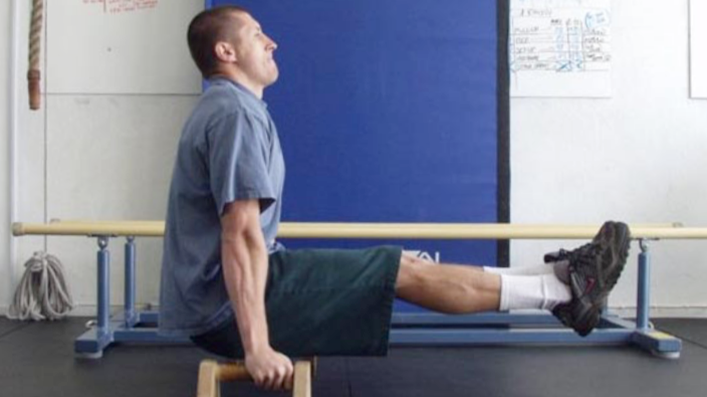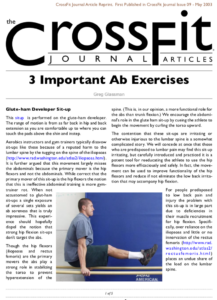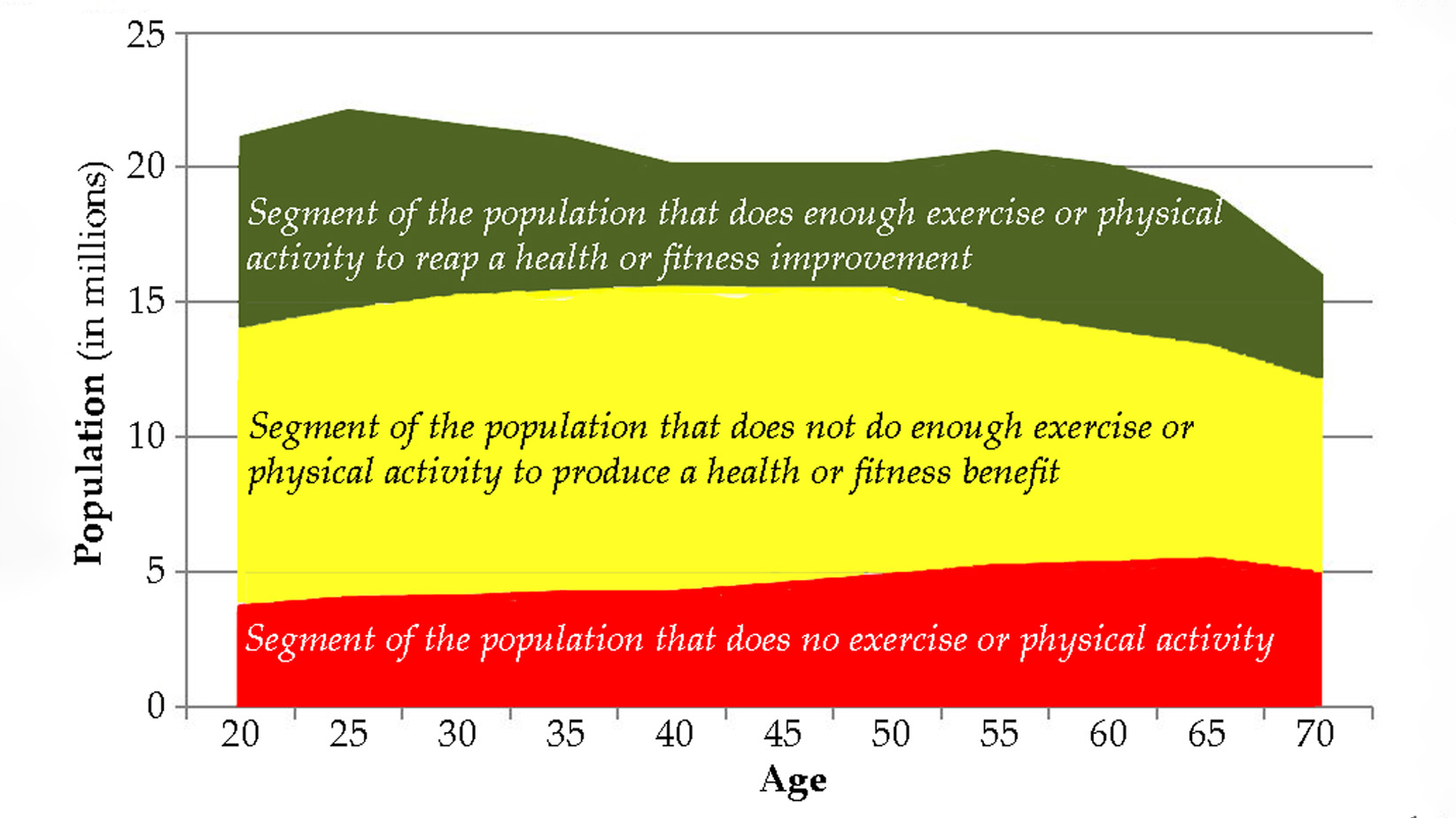By Greg Glassman
This article, by BSI’s co-founder, was originally published in The CrossFit Journal. While Greg Glassman no longer owns CrossFit Inc., his writings and ideas revolutionized the world of fitness, and are reproduced here.
Coach Glassman named his training methodology ‘CrossFit,’ which became a trademarked term owned by CrossFit Inc. In order to preserve his writings in their original form, references to ‘CrossFit’ remain in this article.
Download a pdf of the original article HERE.
Glute-Ham Developer Sit-Up
This sit-up is performed on the glute-ham developer. The range of motion is from as far back in hip and back extension as you are comfortable up to where you can touch the pads above the shin and instep.
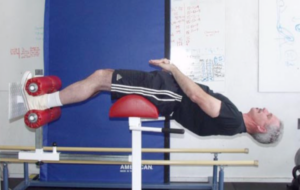
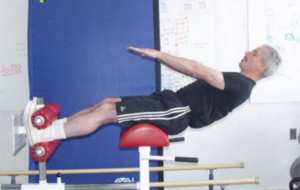
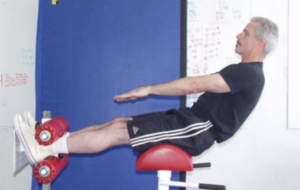
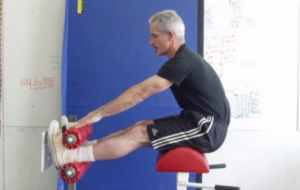
Aerobics instructors and gym trainers typically disavow sit-ups like these because of a reputed harm to the lumbar spine by the tugging on the spine of the iliopsoas. It is further argued that this movement largely misses the abdominals because the primary mover is the hip flexors and not the abdominals. While correct that the primary mover of this sit-up is the hip flexors, the notion that this is ineffective abdominal training is more gym-trainer rot. When not accustomed to glut-ham sit-ups, a single exposure of several sets yields an ab soreness that is truly impressive. This experience should hopefully dispel the notion that strong hip flexion sit-ups don’t target the abs.
Though the hip flexors (iliopsoas and rectus femoris) are the primary movers, the abs play a strong role in stabilizing the torso to prevent hyperextension of the spine. (This is, in our opinion, a more functional role for the abs than trunk flexion.) We encourage the abdominal’s role in the glute-ham sit-up by cueing the athlete to begin the movement by curling the torso upward.
The contention that these sit-ups are irritating or otherwise injurious to the lumbar spine is a somewhat complicated story. We will concede at once that those who are predisposed to lumbar pain may find this sit-up irritating, but carefully introduced and practiced it is a potent tool for reeducating the athlete to use the hip flexors more efficaciously and safely. In fact, the movement can be used to improve functionality of the hip flexors and reduce if not eliminate the low back irritation that may accompany hip flexion.
For people predisposed to low back pain and injury, the problem with this sit-up is in large part due to deficiencies in their muscle recruitment for hip flexion. Specifically, overreliance on the iliopsoas and little or no innervation of the rectus femoris places an undue share of the load on the lumbar spine.
The iliopsoas attaches to both the pelvis and the lumbar spine and if left to perform the bulk of hip flexion, especially under large loads like this sit-up presents, pulls the torso up in large part by the lumbar spine. The rectus femoris by contrast attaches to the pelvis only and when engaged lifts the torso (flexes the hip) by pulling from the pelvis.
The problem arises because few people have learned to fully engage the rectus femoris when powerfully flexing the hip. We’ve used this sit-up to teach our athletes how to fully engage this muscle to improve the quality of hip flexion, greatly assisting the iliopsoas and consequently reducing the load and sheer forces placed on the spine.
We teach powerful recruitment of the rectus femoris by cueing the athlete to attempt to extend the leg, though already extended, and to drive the leg into the pad above the shin and instep. Typically, the athlete will claim that this is what they are doing already, but when they finally “get it” the epiphany is profound and the motion clearly looks different. The coach’s trained eye can readily distinguish between the torso’s rising by being pulled from the spine as opposed to from the pelvis.
With regular practice, focus on proper recruitment and incremental dosage an athlete who once complained of lower back discomfort on performing even a few reps of this sit-up will either find the discomfort occurs at increasingly higher reps or diminishes altogether.
The glute-ham developer sit-up is a gateway exercise to our “medicine ball throw sit-up” which has proven to be a monster exercise for even the best-trained midsections like those found on Olympic throwers. We know one Olympic javelin thrower who offered that the medicine ball throw sit-up was the “toughest ab exercise ever.”
The fact that the glute-ham sit-up is not practiced and held in low regard is another one of the ridiculous bits of malpractice common to most gyms. The hip flexors are extremely powerful muscles and potentiating their development has played a role in our athletes’ dominance.
The Hollow Rock
A seemingly innocuous little exercise, the hollow rock is a staple of gymnastics conditioning and excruciatingly tough when performed correctly.
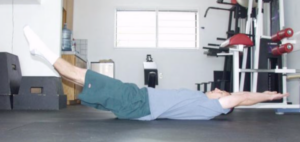
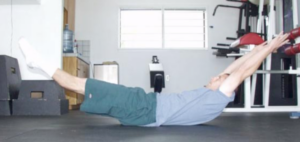

To perform the hollow rock, lay face up on the ground with your arms stretched overhead and legs out straight. Raise your arms and legs about one foot off of the floor and attempt to assume the shape of a rocker on a rocking chair, then gently, slowly, teeter back and forth.
The critical part of this movement is to pull the lordotic curve (lumbar arch) from the back so that the entire back is rounded from shoulders to butt. Initially, you will find that the rocking is rough because of a flat spot in the lower back. This is a perfect measure of both a weakness in and inability to innervate the lower abs.
The role of the hip flexors is fairly insignificant in the hollow rock but the role of the lower rectus (lower abs) is dramatic (recent evidence suggests that the obliques play a major role in lumbar flexion).
For many people the hollow rock is so hard that no matter how hard they try they “clunk” on each rocking as they come to level and the flat spot caused by insufficient lumbar flexion smacks the floor. This “clunking” is a perfect measure of one’s lack of lower ab recruitment.
Lower ab recruitment is the toughest part of ab training and never well developed by most athletes. It is so common as to be a visual cliché that the aerobics instructor who teaches “ab classes” at your local gym can do thousands of crunches but still has a lower abdominal pooch as though three months pregnant. Activation, full recruitment and development of the lower abs require enormous concentration and focus over months if not years. The hollow rock is a near-perfect tool to both test and develop low ab capacity.
You can practice the innervation/recruitment required to engage the lower abs/flex the lumbar spine and perform the hollow rock by standing with your back, feet and head against the wall and pressing hard against the wall at the shoulders and slowly rolling the contact point from the shoulders down to the mid-back, down to the lumbar spine and ending with the butt pushed hard against the wall. You will notice that making hard contact with the wall through the region of the low back is exceedingly hard and requires an anterior to posterior roll of the pelvis and deep low ab contraction. You can test the contact by having someone place a rolled-up magazine in the region of the lumbar curve while you try to pinch it against the wall as they attempt to slide it out. Done right, this produces a distinctive pulling above the pubic bone. That’s your lower abs working. Repeating this 10 times is a great low ab conditioning drill.
Practice the hollow rock even if it gives you enormous difficulties. Start by trying to rock continuously for two minutes regardless of the quality of the movement. Avoid raising the hands and feet to maintain the rocking motion as best you can.
When mastered, the body is dished out flat, the hands and feet are low, and the impetus for the rocking is nearly undetectable. When you can do this smoothly—no flat spot—for two minutes you’ll have the best abs in town.
The L-Sit
This exercise is remarkable from several perspectives. It is isometric, functional and highly effective. Relatively unknown outside of the gymnastics community, this exercise may be the most effective abdominal exercise we know of!
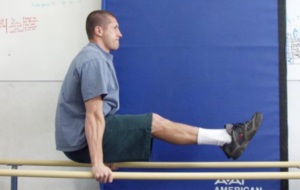

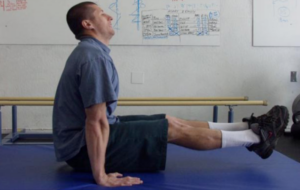
The L-sit is performed by supporting the body entirely by the arms and holding the legs straight out in front. The body forms an “L,” thus the name L-sit. The exercise (we can hardly call it a movement) is isometric, i.e., it involves no joint movement. Being isometric, we quantify its performance not in reps but by time.
We not only contend that the L-sit is functional but that it is the most functional of all abdominal exercises.
Our justification for this contention lies in our view that the dominant role of the abdominals is midline stabilization, not trunk flexion. Though trunk flexion is certainly important, midline stabilization is more important both to everyday living and athletic movement. The leg’s posture in the L-sit places an enormous, if not unbearable, moment or torque about the hip that must be counteracted by the abdominals to keep both the legs up and the spine from hyperextending.
As for efficacy, the L-sit may have no peer among abdominal exercises. We make this claim not on the basis of our position on abdominal muscle functionality but on the simple observation that athletes who have developed their L-sit to the point where they can hold it for three minutes subsequently find all other ab work easy. The gymnasts’ unrivaled capacity at hip and trunk flexion is in large part due to their constant training and practice of this exercise.
We mentioned early the ubiquitous phenomenon of the ab class instructor with the lower abdominal pooch—they cannot hold an L-sit. In fact, if you test the ab class instructor with the lower abdominal pooch for hip flexion strength you’ll find they are super deficient in this regard. You can perform a simple hip flexion strength test by asking the subject being tested to stand on one leg and raise the other knee to hip level while you press down on the knee to see how much, or little, force it takes to push the knee back down. Individuals with the lower abdominal pooch always have super weak hip flexors. We can drive their knee down with one finger. Try this test with someone who has developed the L-sit and you’ll find that they will tip over before the knee will drop. You will not find a three-minute L-sit and a lower abdominal pooch in the same person, yet the world abounds with people who can perform thousands of crunches and sit-ups and still keep the pooch. It’s that simple.
Practice of the L-sit is for some very tough—they just can’t seem to find the muscles that raise and hold the legs. The key is to keep trying. Two successful approaches for working up to the L-sit include hanging from a pull-up bar and raising locked legs as far as possible and holding or working the L-sit by holding one leg at a time alternately in the L posture. Though the L-sit can be performed from nearly any horizontal surface, we recommend parallel bars, parallettes and the floor as platforms for this exercise. The L-sit is hardest from the floor because the floor comes up quickly as the legs sag even a little bit. We use the parallettes for the very reason that it allows practice at less than perfectly horizontal leg position for the beginner, but measuring and competing at the L-sit should be done from the floor. Measure your progress in the L-sit in 15-second increments. Give yourself one point for every 15 seconds you can hold the “L.” Twelve points is your goal and with regular training and practice you should be able to get to 12 points, or three minutes, within six months. During warm-up and cool-down is the natural place to play with this movement, although the dedicated gymnast will find uncountable surfaces and opportunities to play with this superb exercise.
Abs and Hip Flexors
The superstition, confusion and fraud surrounding abdominal development are rampant. Much of this distortion, especially among “experts,” comes from completely misunderstanding the vital role of the hip flexors in controlling and motivating athletic movement and specifically missing the complex interrelationship between the hip flexors and the abdominal muscles. The immediate result of this misunderstanding is the belief that hip flexion exercises are avoided or maligned by most trainers. This is where the “crunch” came from. We put “crunch” into Google and got 990,000 hits compared to 138,000 for “sit-up”; this largely reflects the sit-up’s demise and crunches’ dominance. While the crunch is a good exercise, the idea that it is somehow safer or superior to the sit-up is laughable.
The U.S. Navy SEALS abandoned the sit-up in favor of the crunch and found a rather precipitous rise in running times as a result. The rise in running time was eventually traced back to weak hip flexors and the adoption of the crunch. The crunch had been initially adopted because the sit-up was linked to lower back injury. Dr. Fred Koch developed the “AbMat” in a rather brilliant analysis of the sit-up. While the AbMat sit-up is a great exercise and a dramatic improvement on the traditional sit-up we believe Dr. Koch may have missed the vital role of the hip flexors in abdominal training. We are also of the opinion that the Navy’s problems with the original sit-up were due to the violent nature of the old sit-up’s biphasic movement (notice sit-ups usually have a violent 1,2 count as the abs throw the load to the hip flexors as described in the above link.) and the near-total lack of hip extensor training in traditional Navy SEAL physical training and not solely because of the hip flexors’ dominance in the older movement.
CrossFit’s position is that the Navy made the right, if not brilliant, move in replacing the biphasic traditional sit-up with the AbMat sit-up but still doesn’t fully appreciate the hip flexor’s role in athletic training—and the need to balance ab exercises with hip extension movements like the squat and deadlift. The current synthesis is indeed an improvement but not the last word in ab training by any means. We’ve found it easy to convince anyone of this view in just a few months of training.
Greg Glassman founded CrossFit, a fitness revolution. Under Glassman’s leadership there were around 4 million CrossFitters, 300,000 CrossFit coaches and 15,000 physical locations, known as affiliates, where his prescribed methodology: constantly varied functional movements executed at high intensity, were practiced daily. CrossFit became known as the solution to the world’s greatest problem, chronic illness.
In 2002, he became the first person in exercise physiology to apply a scientific definition to the word fitness. As the son of an aerospace engineer, Glassman learned the principles of science at a young age. Through observations, experimentation, testing, and retesting, Glassman created a program that brought unprecedented results to his clients. He shared his methodology with the world through The CrossFit Journal and in-person seminars. Harvard Business School proclaimed that CrossFit was the world’s fastest growing business.
The business, which challenged conventional business models and financially upset the health and wellness industry, brought plenty of negative attention to Glassman and CrossFit. The company’s low carbohydrate nutrition prescription threatened the sugar industry and led to a series of lawsuits after a peer-reviewed journal falsified data claiming Glassman’s methodology caused injuries. A federal judge called it the biggest case of scientific misconduct and fraud she’d seen in all her years on the bench. After this experience Glassman developed a deep interest in the corruption of modern science for private interests. He launched CrossFit Health which mobilized 20,000 doctors who knew from their experiences with CrossFit that Glassman’s methodology prevented and cured chronic diseases. Glassman networked the doctors, exposed them to researchers in a variety of fields and encouraged them to work together and further support efforts to expose the problems in medicine and work together on preventative measures.
In 2020, Greg sold CrossFit and focused his attention on the broader issues in modern science. He’d learned from his experience in fitness that areas of study without definitions, without ways of measuring and replicating results are ripe for corruption and manipulation.
The Broken Science Initiative, aims to expose and equip anyone interested with the tools to protect themself from the ills of modern medicine and broken science at-large.
Support the Broken Science Initiative.
Subscribe today →
recent posts
Expanding Horizons: Physical and Mental Rehabilitation for Juveniles in Ohio
Maintaining quality of life and preventing pain as we age.
